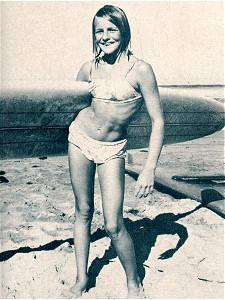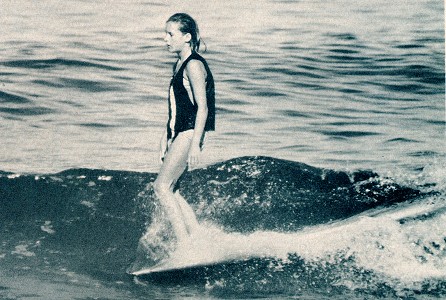surfresearch.com.au
 |
surfresearch.com.au
surfer
: duke and makaha contests, 1965
|
Surfer
Magazine : Duke and Makaha Contests, 1965.
Surfer: Duke and Makaha
Contests.
Surfer
Volume 7 Number
1, March1966.
This copy
courtesy of the Graham Sorensen Collection.
Introduction.
The contest
articles cover the winter of 1965-1966, with a publishing delay
of several months.
While the Duke
Contest was a great success, marking the emergence of 17
year-old Jeff Hakman, there were numerous dificulties with the
Makaha Contest.
The Menehunes
Contest at La Jolla marked the emergence of 12 year-old
Margo Godfrey.
The Pipeline
column featured Joyce Hoffmann, the USSA 1965 standing,
Australia's Ma and Pa Bendall, the upcoming Peru International
Championships, and Bob Cooper's relocation to Alexandra
Headland in Queensland.
In advertising,
Jacobs Surfboards promoted The 422 (page 18), a board
with "flyers" reducing the tail section; a precursor to Ben
Apia's Stinger in 1974..
Duke Kahanmoku's
famous aloha-print tennis shoes were advertised on page 90.
Other Articles
Mike Doyle:
Getting The Most Out Of The Surf, Surfer Tips Number 20,
page 20,
Griffin and
Stoner: Le Adventure Surf Francais, page 38.
J.J. Moon: I'm
the
number one surfer!, page 56.
Patrick McNulty:
Mehehunes Show class at Shores,
page 62.
Third Annual
Surfer Poll, Nominations and ballot paper, page 77.
Pipeline, page 78.
Bill Cleary: Rincon,
page 82.
Advertising
Hansen surfboards: new glass, new shapes
(standard,custom, noseriders, guns, semi-guns), new fins (three
shapes), page 22.
Page 23
Makaha Takes a Back Seat
"DUKE" CONTEST MATCHES HAWAIIAN SURF GREAT!!!
Imagine the
perfect surfing contest. .. there's a select field of 24 of
surfing's greatest.
... Names like
Strauch, Miller, Weber, Hynson, Hollinger, Dora, Cabell, Frye,
Hemmings, Noll, Downing.
...And they
wait until the surf is big and hairy.
...Where?
There's really
only one place for the perfect contest - on a big day at
Sunset Beach off Oahu's north shore.
... And
everything comes off perfectly.
That's a
capsule description of the first Duke Kahanamoku Invitational
that in one day of great surfing moved the previously
unchallenged Makaha International far out of the tIawaiian
competition spotlight.
Organizers of
the Duke contest went out of their way trying to avoid a
direct comparison with the 12-year-old Makaha classic, but a
comparison was inevitable.
From beginning
to end, the Duke contest - unlike Makaha - was a marvel of
organization, planning, and probably the greatest overall
surfing ever put together in one competition.
By comparison,
Makaha dragged nine days in mostly mediocre surf and was a
mish- mash of crowded heats (over 550 signed up), questionable
judging - so badly organized that many name surfers didn't
even know the day of their heats.
"No questions
about it," grinned Mickey Munoz, "the 'Duke' contest was the
greatest ever held."
The contest
also rocketed to greatness little Jeff Hakman, 17, who tore
apart his favorite Sunset Beach break as veterans twice his
age failed to qualify for the finals.
Organization
was the keynote of the Duke contest and was superbly run from
the moment the specially selected con-
Page 24
testants
checked in to the posh Surfrider Hotel.
The surfers
had a complete briefing on how the contest would be scored,
and every surfer knew exactly what the judges wanted.
The only mild
sour note was sounded in a few heated discussions among the
judges about what emphasis to put on a wave ride. Meet
director Fred Van Dyke had selected the three judges to get a
wide range of judging.
Contest
director Van Dyke commented:
"Our judges
were representative of all ages and schools of thought in
surfing.
Mark
Martinson, the youngest and hot-dogging exponent; Buzzy Trent,
the middle-aged' big-wave rider; and Wally Froiseth, the older
and wiser and most experienced of all surfers."
However,
Martinson- who passed up the contest because a leg broken in a
surfing accident had failed to mend completely- frequently was
at odds with Froiseth and Trent about giving more points to
performance on the big Sunset peaks.
But when it
was allover, there was no doubt that California-born Hakman,
who now lives in the Islands and attends Punahou school, was
the class of the field; Commented Froiseth:
"Jeff Hakman
surfed as good as any- one I've ever seen at Sunset Beach.
He took eight
waves in the finals and was judged on five of them.
He was up
against some terrific competition, but there was no question
he was the best."
Buzzy Trent
said, "In my fifteen years at Sunset, I've never seen anyone
ride the waves better than Jeff.
You just can't
surf better at Sunset. Jeff got the best rides on the best
waves."
The little
champion, who stands just 5 feet 4 and weighs 125 pounds,
piled up 219 points out of a possible 300.
This was 28
points more than second-place Hawaii's Paul Strauch, Jr., and
35 better than Felipe Pomar, the transplanted Peruvian who
attends Oahu's Church College.
Hakman, who
later missed the Makaha junior competition because of a
traffic accident, was unruffled by his Duke Kahanamoku victory
over the cream of the surfing world.
Hakman
commented:
"I've surfed
on better days at Sunset, but that one ride I got was the best
I've ever had."
The ride
(caught by SURFER's sequence camera, see page 26) was
described by veteran Trent as "a one in a million shot.
He harnessed
the wave.
It was the
equivalent of running the hundred yard dash in nine seconds
flat or hitting a home run with the bases loaded.
It was the
best ride I've ever seen at Sunset Beach.
Jeff never
made a mistake."
Van Dyke had
scheduled the contest for December 13-17, picking the best
wave conditions at either Sunset, the Banzai Pipeline, Haleiwa
or Waimea
Page 25
[Photograph]
... while
this ripple crowded with five surfres was typical of the
waves during preliminaries of the Makaha International.
That's
George Downing, number 5, who picked up his third Makaha
title. Cleary photo.
This same
photograph was printed on page 36 the next edition of Surfer,
illustrating an article by Dewey Weber.
Weber is number
4.
For the article
and image, see Dewey Weber : Contests,
Surfer, Volume 7 Number 2, May 1966.
Bay.
It rained on
the l3 th, but that night at a lavish steak dinner and party
at the Duke's famous restaurant at Waikiki, the word went out
- the surf was up!
So that
morning the chartered bus was loaded with boards and surfers
and headed for the north shore.
Van Dyke cast
an expert's eye on the big peaks falling at Sunset and said:
"This is it."
The sun was
hot, and a good-sized crowd scattered along the long elipse of
sand as photographers lined up, side by side, shooting in
unison like a firing squad.
Gathering
place for the surfers and the CBS crew photographing the
action was Val Valentine's ocean-facing house.
A soft drink
and sandwich bar was set up in the backyard, and the 24
surfing stars lounged and waited for their heats, which were
so beautifully run that the entire contest was wrapped up in a
single day.
There were no
side events, no tandem, no women's, no juniors- just a lean,
hard professional contest, an exercise in classic simplicity.
Two surfers
were picked out of each of the four heats for the finals.
In many cases
only a point or two separated the winners from the losers, as
the three-man judging team turned in exceptionally even scores
for the best five waves of each surfer.
The surf was
12 feet and mean.
Robert August,
waxing up for a heat, watched a big Sunset tunnel explode,
spitting a cloud of stearn that licked Peter Cole cleanly off
his board.
"Did you see
that?" said August.
"How can I
ride this place? I've never ridden it before."
But August did
well, scoring 122 points in his heat that big Mike Doyle won
with 185.
August took a
couple of swims as did Butch Van Artsdalen, Joey Cabell and
Mickey Munoz, among others.
Richard Chew,
who prefers smaller surf and gets in the water at Sunset only
rarely, had the worst showing as he spent most of the
55-minute heat swimming after his board.
Dora, the
Black Knight of Malibu, found himself boxed again and again on
waves by other surfers- and you don't push anybody off his
board at Sunset.
Mickey went
for the long swim twice and later commented on the beach:
"Sunset has
got to be the world's greatest surfing spot - the place is
beautiful, but I don't like waves I can't control.
You're at the
wave's mercy at Sunset.
It controls
you.
I was stuck to
those waves like fly paper!
And I still
spent the whole day swimming."
The eight
finalists took to the water at 3 p.m. as the off-shore trades
kissed the waves now breaking hollower and harder.
Hakman looked
like a little boy sent to do a man's job with Paul Strauch,
Jr., Felipe Pomar, Jackie Eberle, Mike Doyle, Bobby Cloutier,
Corky Carroll, and Kimo Hollinger.
But Jeff soon
had
Page 26
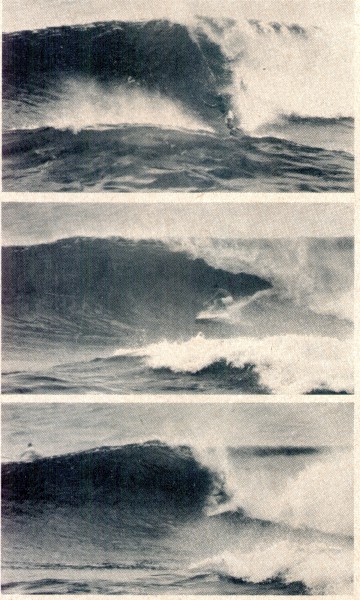 |
Jeff
felt no doubt that Sunset is his favorite surfing
break as he
(A)
cranked a neat bottom turn
(B)
trimmed beautifully and drove close to the hook
and
(C)
then disappeared in the tunnel.
|
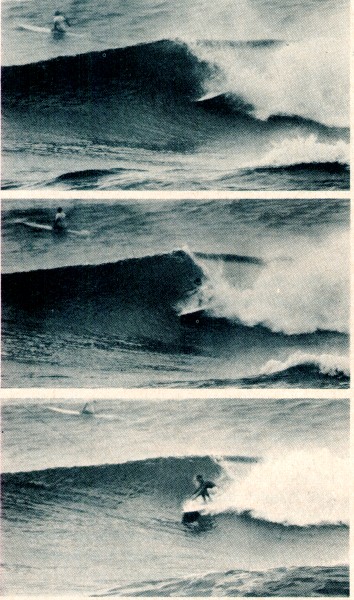 |
(D)
Still inside,
(E)
Jeff incredibly flashes out the exploding tube
(F)
and slides into green water with a happy smile for the
cameramen on the beach. |
[Other
photographs]
Page 27
[Photographs]
Page 28
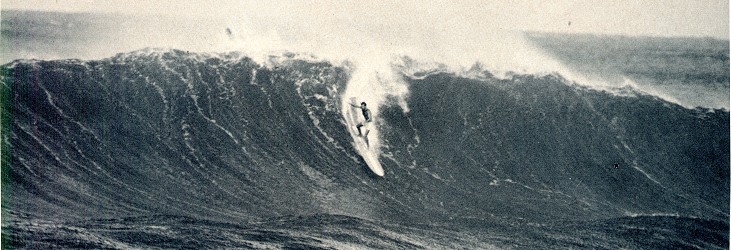
Malibu's
Mickey Dora shows the famous Dora style as he drops in on
a Sunset wave
blown
smooth by thee off -shore trades. Cleary photo.
every eye on
the beach focused on his roller coaster style, dropping,
accelerating, climbing - once disappearing completely inside a
curling wave and then reappearing, rising casually over the
top as the spitting wave spun on.
There were no
arguments when the name Hakman was selected as the first
engraving on the perpetual Duke Kahanamoku Invitational
trophy.
The Duke
contest, if nothing else, pointed out the shortcomings of the
Makaha contest's nine days.
Except for the
exciting tandem competition, Makaha was a badly run fiasco.
The Makaha
competition hardly lived up to its "International"
classification and without representatives from surfing spots,
Australia, South America, France and South Africa, the Makaha
applause was but the sound of one hand clapping.
The day before the contest opened, there was point surf
booming off the point and crushing through the bowl.
When the
contest opened, the swell had dropped and the Men's
eliminations were held in small, fun surf.
The surf
dropped to almost nothing, the meet was put on a day-to-day
basis.
Contestants
were advised to call each morning to see if their heats were
scheduled, but this led to a great deal of confusion and many
contestants relied on listening to local radio stations for
announcements whether the meet was on or off for that day.
The Waikiki
Surf Club, sponsor of the Makaha lnternational, made it easier
for contestants on the north shore to get to Makaha by driving
through a military reservation and the Koli Koli Pass.
So travel time
for the north shore commuters was pared to an hour.
Suddenly the surf picked up and the Women's event was
underway.
The favorite,
of course, was 1965 USSA champion Joyce Hoffman of Capistrano
Beach, California, described in the program as "clearly the
world's greatest woman surfer."
But some of
the other lady competitors didn't see it that way, and the
Women's Finals nearly turned into open warfare.
Constantly
under attack, Joyce got few waves to herself and received at
least one solid bump on the head.
The winner was
Nancy Nelson, notching her third Makaha victory.
Nancy, of San
Clemente, California, rode for all she was worth and stayed
out of the battle.
Nancy
commented later: "I would have hated to have been in Joyce's
position.
The way they
went after her was horrifying!"
The surf
dropped again but picked up for the tandem competition that
was the
Page 29
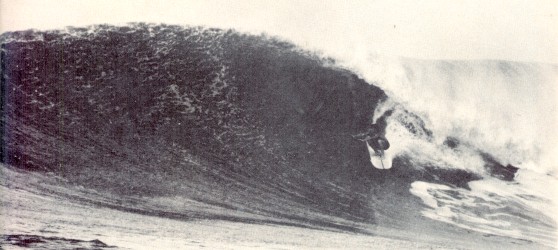
Perfectly
trimmed and driving, Paul Strauch Jr., exhibits the type
of riding
that
earned him second place in the Duke K. contest. Stoner
photo.
[Also
photograph: Mickey Dora wipe-out.]
Page 30
contest's
highlight.
Just before
the finals, Mike Doyle looked around frantically for his
partner, Linda Merrill - and no Linda!
Linda was a
victim of the badly announced programming and was at that
moment driving frantically to Makaha after learning on the
radio that the tandem was scheduled.
With no Linda,
Doyle spotted Don Hansen's tandem partner, Danielle Corn of
Encinitas, California, and asked if she would fill in.
As Mike and
Danielle paddled through the channel, Linda Merrill came
running down the sand- but it was too late.
Mike Doyle,
even with a new partner, rose to the occasion, taking his
third Makaha tandem title that, together with his third-place
finish in the Men's finals; earned Mike the contest award for
all-around surfer.
After the tandem, finals for the Men's juniors were called
with many big-name juniors unaware that they would be surfing
that day.
Among the
stars still on the North Shore were Jock Sutherland and the
favorite, Jeff Hakman, who had beat 'em all the "Duke"
competition a few days earlier.
Friends made
panic telephone calls I trying to round up missing finalists.
Sutherland was
surfing in front of his house at Chun's Reef when his mother
got the call from Makaha.
She flagged
Jock in with a towel and together they sped over the
"impassable" back road around Kaena Point trying to save time.
The Kaui helicopter service, doing a land office business
selling rides over the waves at three dollars a minute, went
chopping off in a patriotic, but unsuccessful, trying to
locate missing contestants on the highway.
Hakman was on
his way when his car was in a minor accident.
There were no
injuries, but Jeff had to stand by to make a police report,
and he never did make the finals.
Sutherland
arrived with the finals in full swing with just fifteen
minutes left.
Running down
the sand, he grabbed a numbered jersey and clutched it between
his teeth as he paddled out into position in one of the
speediest runs to the line-up the Makaha channel had ever
seen.
Jock caught
five waves- the minimum to be judged- but David Nuuhiwa, who
had been in the water the full 55 minutes, was declared the
winner- but just by a single point.
Gracious in
victory, the new
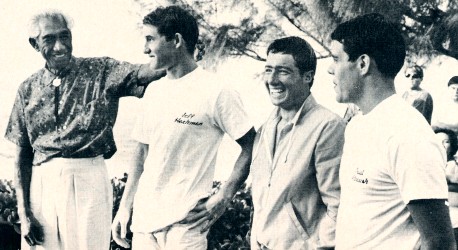
Duke
Kahanamoku
had a warm smile for winner Hakman, third-place Pomar and
second-place
Paul
Strauch after the contest that many top surfers described
as "the greatest one ever," Stoner photo.
Page 31
[Photographs]
Page 32
junior
champion commented later: "If Hakman had made it here, I don't
think I could have beat him."
The surf
flattened out for several days, and the day after Christmas
the Men's semi-finals were called.
This was the
last possible day to hold the Men's event, because many
contestants were flying back to the Mainland the next day.
Then, almost on cue, the surf started to come up.
During the
semi-finals, it built up from four to six feet, as the
contestants started flocking to Makaha.
Several were
unaware of the contest, among them John Peck, one of the
favorites.
John got the
word at the last minute, borrowed a competition motorcycle and
came roaring around the rugged Kaena Point road. He arrived
bruised and muddy- but too late for his semi-final heat.
The surf
gradually got larger and as considered adequate by T. V. for
the finals, although George Downing and others objected. The
waves were four to eight feet during most of the 55-minute
event, and there were some great hot-dog performances by
Doyle, Dewey Weber, Paul Strauch, Jr., Fred Hemmings and Joey
Cabell.
Cagey George
Downing, who waited for larger waves and rode in the relaxed
Island style that is so popular with Makaha judges, was the
victor by one point for an unprecedented third Makaha title.
Hemmings,
Doyle and Buffalo Keaulana were all tied with 36 points for
their total score on their best three waves.
The judges
finally sorted them out by looking back until they found a
point difference in the waves they caught during the 55-minute
finals.
After the
contest, as usual, there were plenty of gripes: the bad
organization, the heats crowded with as many as 23
contestants; and above all, the judging.
In defense,
head judge Wally Froiseth said: "We changed our judging system
from last year and have gone from the buoy system stressing
the long ride to the 20-point system.
But we still
feel that a surfer who catches a wave outside and
Page 33
[Photographs]
Page 34
[Photograph]
Better
late than never was red-hot junior Jock Sutherland, who
just missed beating
David
Nuuhiwa with only 15 minutes' surfing time left in the
55-minute finals. Cleary photo.
rides it all
the way to the shore definitely has more opportunity to
perform and will, on the average, get more points.
Regarding
international judges, I feel that until the level of ability
in the different countries gets a little closer together, it
is not a good idea.
I do feel that
judges from California are well qualified, and we have asked
them to judge here. .. but we will not use a judge who does
not go through our judges orientation program (usually run
well in advance of the contest).
We don't want
to tell them how to judge.
We just want
to be sure they are considering all the facets of surfing we
feel are important."
Another Makaha
judge, ex-Santa Monica lifeguard and surfer Dave Rochlen, Sr.,
had this to say:
"The Makaha
contest is a crowd event.
It is for the
public.
We spent more
time weeding out more people.
At Makaha,
everybody gets a chance.
A guy from
Nebraska can come out here and enter.
It is planned
and executed for the public.
And after it
is all over. ..we hope we have produced a champion.
The Duke
Kahanamoku meet as an invitational is
Page 34
extremely
spectacular.
But I think
there is room in surfing for both."
What Rochlen
failed to mention, however, is that while a mythical surfer
from Nebraska can enter the Makaha International, only two
non-Hawaiians have won in the contest's 12-year history.
They were
California's Peter Cole in 1958 and Aussie Midget Farrelly in
1962.
Year after
year, the same names pop up in the finals.
In fact,
several Hawaiian surfers have been in the Makaha finals almost
every year they've entered.
Can the surfer
from Nebraska win the Makaha contest?
Is it really
an International event for everybody?
Or is the
judging geared to an outmoded style that obviously belongs to
the past?
George Downing
is a great surfer- on the point at Makaha and in big surf.
But his
victory is garnered in the shadow of questionable judging -
unfair to George and other contestants instructed to "perform"
in the Makaha contest.
The size of
the waves George caught gave him the point edge.
But the
question here is why are more points given for an eight- foot
wave than a six-foot wave?
Cer-
Page 35
tainly no more
danger is involved.
However, if a
contestant riding in the finals on an average 18-foot point
day at Makaha picked off a 25-foot wave and made it, he would
deserve more points.
In that case,
the bigger wave is obviously more of a challenge and a greater
feat.
But Makaha
doesn't claim to be a "ride-the-biggest-wave contest."
According to
judge Wally Froiseth, "We still feel that a surfer who catches
a wave outside and rides it all the way to the shore
definitely has more opportunity to perform and will, on the
average, get more points."
Evidently,
merely the opportunity to perform is sufficient, and George
Downing once again has won the annual Makaha "long distance
surfing championship."
But one thing
is certain.
In the Duke
Kahanamoku event, the Hawaiian Islands at last have a contest
to match their waves.
Duke
Kahanamoku Contest Finals and Individual Judges' Point
Allotment (best 5 waves) [Adjusted]
[Surfer]
1.
Jeff Hakman
2.
Paul Strauch, Jr.
3.
Felipe Pomar
4.
Jackie Eberle
5.
Mike Doyle
6.
Robert Cloutier
7.
Corky Carroll
8.
Kimo Hollinger |
Buzzy Trent
72
63
61
59
61
57
58
57
|
Mark Martinson
74
62
58
61
58
58
57
58
|
Wally Froiseth
73
66
65
63
60
64
60
58
|
Total
219
191
184
183
179
179
175
173 |
Makaha Results
MEN'S
1.
George Downing (Hawaii)
2.
Fred Hemmings, Jr. (Hawaii)
3.
Mike Doyle (California
4.
Buffalo Keaulana (Hawaii)
WOMEN'S
1.
Nancy Nelson (California)
2.
Joyce Hoffman (California)
3.
Joey Hamasaki (Hawaii)
|
JUNIORS
1.
David Nuuhiwa (Hawaii)
2.
Jock Sutherland (Hawaii)
3.
Stanley Park (Hawaii)
4.
Ronald Mahelona (Hawaii)
TANDEM
1.
Mike Doyle-Danielle Corn (California)
2.
"Pete" Peterson-Marge Giger ( California)
3.
Leroy AhChoy-Diane Beach (Hawaii)
4.
Bob Moore-Pat Young (Californnia)
|
Page 37
[Photograph]
Page 62
Menehunes Show Class at Shores
By Patrick McNulty / Phots by Ron Stoner
Menehunes were
out in force for a contest all their own.
In Hawaiian
lore, a Menehune is a mischievous little fellow.
In other
countries, he'd be called a leprechaun or an elf, so none of
the contest spectators were surprised when the 34 little
rascals showed up with plenty of surfing tricks.
On their
Menehune-sized boards, they ripped into the three to four-
foot surf at La Jolla Shores near San Diego in the contest
sponsored by the Windansea Surf Club.
Just
like senior surfing contests, the competition was fierce,
the performances excellent and shiny trophies went to the
winners.
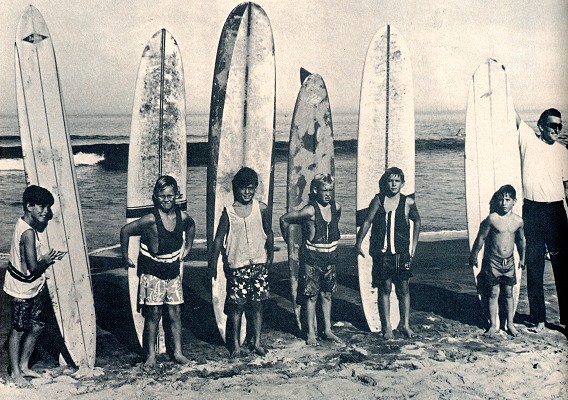
(Above)
Big Mike Doyle stretches up and shows the size of
contestants boards as be poses with winners.
That's
winner Chris Picciolo at the far left.
Page 63
The Menehunes
came from many parts of Southern California, as far north as
Ventura and Malibu.
Youngest
entries were Jim Palmus and Ted Stout, both nine years old.
The "old
timers" included David Tompkins, Niki Rodrigues and Moose
Schumacher- all 12 years old, which was the age limit for the
contest.
Blonde Margo
Godfrey, one of the three girls in the contest, surfed off
with top honors in the 12 year old division- which included
boys and girls.
Margo was
surfing her home break at La Jolla Shores and she turned on
with some fabulous nose rides that really showed the boys up.
In the ten
year old division, Judges Chuck Hasley, Skip Frye, John Close
and Pat Higgins had a tough time sorting out the best of these
red-hot little surfers.
Ten year old
Chris Picciolo, a daring noserider from Pacific Palisades,
California, was voted the winner.
Chris really
showed signs of becoming a great hot dogger in later years.
These
Menehunes ripped into the La Jolla Shores beach break and
left no doubt that they are well on their way to becoming
Joyce Hoffmans and Mike Doyles of the future.
(Above
left)
Twelve-year-old Margo Godfrey was all smiles after winning
the 12-year-old division which was open to both boy and
girl Menehunes. (Above right) Margo demonstrates her
relaxed style that she perfected on her home break at La
Jolla Shores.
Page 78
PIPELINE
RUSTY MILLER,
CHAMP .
Rusty Miller
is the new 1965 USSA champion in a wild contest year that was
a scramble down to the final contest.
Miller had an
imposing 400 points going into the Santa Monica Mid-Winter
Surfing Championships, December 18- 19, but Skip Frye, with
345 points, had a shot at the title.
Rusty, in the
Islands with many top surfers for the Duke Kahanamoku and
Makaha contests, didn't jet back to the mainland for the Santa
Monica competition.
But Frye and
other USSA high-point men Donald Takayama and Corky Carroll
flew to Santa Monica from Hawaii hoping to pick up some
valuable points.
Their plans
were really shaken by Marty Sugarman, a relatively unknown
surfer from Santa Monica.
Sugarman
knocked off Frye in a preliminary heat, eliminated Takayama in
the semi-finals and then finished first ahead of second place
Carroll in the finals.
Vic Moreno was
third, Tom Lewis fourth and Tom Overland fifth.
Frye and
Takayama, of course, got no points, but Carroll picked up 75
third-place points which moved him from thirteenth up to fifth
position in the final USSA standings.
Carroll, who
just a few days before had finished seventh in Duke Kahanamoku
Invitational at Sunset Beach, showed his usual hotdogging
style in the small three-four feet Santa Mqnica surf.
But he
couldn't match giant-killer Sugarman's inspired surfing.
Denny
Thompkins enhanced his USSA point standing by winning the
Santa Monica contest's junior division ahead of Mike
Stevenson, David Nuuhiwa, Herb Torens and Bill Gray.
Mary Lou
McGinnis took women's honors ahead of Margo Godfrey, but this
had no impact on the women's standings since Joyce Hoffman had
wrapped up the competition early with a maximum 500 points.
These are
the final USSA 1965 standings:
1.
Rusty Miller
2.
Skip Frye
3.
Donald Takyama
4.
Dewey Weber
5.
Corky Carroll
6.
Richard Chew
7.
Steve Bigler
8.
Mark Martinson
9.
Robert August
10.
Mike Doyle |
Juniors:
1.
David Nuuihwa
2.
Denny Tompkins
3.
Petey Johnson
4.
Herb Torrens
5.
Mike Stevenson
Women:
1.
Joyce Hoffman
2.
Joey Hamasak
3.
Nancy Nelson
4.
Josette Lagardere
5.
Dede Arevalos.\
|
SURFING
SURGEONS
The parking
lot at Kaiser's Hospital between Waikiki and Ala Moana in
Hawaii has a crowded surfboard rack for a unique Island
version of a doctor's coffee break.
Many of the
physicians at the hospital are avid surfers and use their
spare time for quick trips to the surf at the hospital's door
step.
Ron Haworth
reports that just before slipping under an anesthetic, one
patient managed to mutter, "How was the surf today, Doc?"
Scalpel
poised, the surgeon replied, "Five to seven with offshores."
So the patient
dropped into dreamland with visions of tight, tempting tubes.
Not a bad way
to lose a tonsil.
Page 79
NORTHERN
NORTHERN OUTPOST
"Here's a shot
of Bill Waterrnan on a super clean left in an area that SURFER
Magazine is really rnissing-Oregon," complains Scott
Blackrnan, an enthusiastic surfer frorn Agate Beach, Oregon.
"SURFER's
neglecting northwest surf," says Blackrnan, "the entire East
Coast frorn Florida to Rhode Island has been covered and
rightfully so.
But your West
Coast coverage seerns always to stop at San Francisco, which
is called by one of your readers- 'surfing's northern
outpost.'
If surfing has
a northern outpost, it's up here in Oregon where we surf year
around- especially at Agate Beach where the mile-long point
narned Yaquina Head gives protection frorn prevailing summer
westerly winds.
We surf the
south side and switch north when fall brings southerly winds.
There is
frequently some great small surf."
JOYCE HONORED
Speaking of
Joyce Hoffrnan, she added to her own growing laurels- and
indirectly gave surfing a trernendous prestige boost when
Joyce was nominated for Woman of the Year by the influential
Los Angeles Times newspaper.
Selected for
her surfing exploits, Joyce, 18, was the youngest of the dozen
nominees who included rnovie star Julie Andrews, historian
Ariel Durant, voted Woman of the Year, astronorner Doctor E.
Margaret Burbidge, heart specialist Doctor Marian E. Gallaher
and painter-sculptor Joyce Tremain.
The fact that
Joyce, as a surfer, was included in this select cornpany, and
the recognition by one of the nation's great newspapers does a
lot to offset the poison pen type of anti-surfing article that
ran recently in Sports Illustrated.
SURFER extends
congratulations to Joyce and the Los Angeles Times.
BIG SURF
TIPPER
Here's the
plot: There's this pretty blonde girl surfer, and she wants to
enter the Makaha contest.
But she
doesn't have much rnoney, so she quits school and works as a
waitress to raise the plane fare from Southern California to
Hawaii.
As the contest
gets closer and closer, she still doesn't have enough dough.
Then who
cornes into the restaurant one day but this rnulti-millionaire
who asks the owner, "How does that pretty blonde keep such a
good tan in the middle of winter?"
And so the
owner tells him the whole story about the blonde surfer and
how she wants to go to Hawaii.
So, after he
finishes his pie ala mode and coffee, the millionaire leaves a
tip under the plate-a pair of one hundred dollar bills.
The waitress
picks them up, starts to cry and then runs away with the $200
to buy her plane ticket for the contest.
Sound corny?
Well, it
actually happened to pretty Kathy O'Connor, hot Southern
CaJifornia surfer and newly elected president of the women's
division of the Windansea Surf Club.
Kathy had
dropped out of Oceanside Junior College to work at the Texas
Melody Ranch in Vista when she ran into the big-tipping
millionaire from Los Angeles.
"Without that
$200 tip, I probably wouldn't have gone to the Islands," said
Kathy.
Page 80
AFRICA - HOME
OF SURFING?
Is Africa- not
Hawaii- the real home of surfing?
That's the
opinion of surfing pioneer Tom Blake, who says he has evidence
to back up his claim that the Africans really invented
surfboard riding, Blake says that recent evidence points to
surfing's origin in equatorial West Africa perhaps thousands
of years ago.
Blake said
that a thesis by a University of California student has
confirmed a historical report by a British explorer about
surfboard riding at Accra, Ghana, along Africa's gold coast in
1837.
Blake says,
"In 1837, surf riding was going strong in West Africa, while
in Hawaii, it was a dying sport.
Long before
the time of Christ, sea trade flourished in the Mediterranean
and along the sea coasts of Europe and Africa and physical and
cultural contacts have been established.
Conclusion:
Surf riding originated in West Africa untold thousands of
years ago and the idea then slowly spread by diffusion of
those who had seen it or participated in it to the Middle
East, India, Asia, Tahiti- reaching Hawaii about the tenth
century. "
Blake says he
also has evidence that "paddle boards were known in Africa
among the Ashanti tribe long ago."
"There are
drawings," Blake said, "of long, slender boards called
'mapaoua' paddled by hand around an island lake.
The use of
oars, paddles or sails was forbidden, leaving the paddleboard
the main form of transportation."
Blake adds,
"Surely there are now people living in West Africa and written
records that could shed more light to further support this
theory that Africa is indeed the home of surfriding."
GRANDSURFERS
Meet
Australia's oldest gremmies - Grandma and Grandpa Bendall, who
surf everyday of the year.
"You can keep
your bowls and golf," says Ben Bendall, 57, "we find surfboard
riding keeps us fit, and we really enjoy it."
Writer Lawrie
(sic, Laurie?) Kavanagh reported in the Brisbane Courier
Mail: "Living right on the ocean at Caloundra Beach, the
Bendalls find ample time to do their surfing and think nothing
of traveling hundreds of miles a week chasing the best surf.
In the Bendall
garage is a two-berth van built especially for surf chasing.
The van
contains everything including the kitchen sink to make living
away from home more than comfortable.
The van is
always fueled and provisioned, ready to hit the road for the
big surf if the waves look like they're holding for several
days at some distant beach.
If you think
the Bendalls are surfing fanatics, you're right.
They live for
it. Mrs. Madge Bendall, 55, grandmother of three, made news
last year when she entered the state surfboard riding
championships and her husband Ben says they are going to keep
on surfing for a long time.
"We're going
to ride waves as long as we've got two feet to stand on."
PERU BOUND
Finishing
one-two in the USSA annual ratings earned Rusty Miller and
Skip Frye a free trip to the Peru International Championships
next February 25 through March 4.
Page 81
Two surfers
from every competing country get official invitations and
contest director, Eduardo Arena, decided to use the USSA
competition results to select the top American surfers.
There's still
time to sign up for the Peru International, which is one of
the top contests of the year.
Any interested
surfers can get more information by writing Eduardo Arena,
Apart-do 180, Lima, Peru.
THE COVE
A bit of
surfing history: Back in the 1930's a hard-muscled oldtimer
was a familiar figure at a chilly cove near San Francisco's
Cliff House.
Everyday-rain
or shine, winter or summer-since he had been a youngster, the
old fellow had splashed into the surf for a swim out to the
Seal Rock landmark and back.
It was
frequently a tough swim because the cove was famous for strong
riptides, big surf and chilly water.
But that
didn't stop the old timer.
He loved the
cove and the ocean, frequently telling companions that when
the time came for him to pass on to his reward this beach
would be quite suitable.
And so on May
31, 1938, he swam into the breakers and collapsed on the sand
with a fatal heart \ttack.
Sam Kelly was
dead at 74.
And that's how
Kelly's Cove got its name.
BELGIUM
WIPEOUT
Surfer Dan
Cole, who lives in Belgium, wanted to stay in shape for a
winter's surfari to the excellent French surf at Biarritz.
Since there
are no waves in Belgium, Dan broke out a skateboard for a
little sidewalk surfing just to keep in practice.
But the
Belgium police take a dim view of skateboarding, and Dan was
arrested and fined for the following "crimes":
(1) Driving a
four-wheeled vehicle without a license.
(2) Driving
over 40 kilometers an hour.
(3) Driving a
vehicle without a valid driver's license.
(4) Driving a
vehicle without lights, horn or brakes.
Dan reports
he's going to stick to ocean surfing after this.
DOWN UNDER TO
STAY
So you think
American surfing breaks are getting too crowded?
So did Bob
Cooper, 28, California surfer and artist who has moved
permanently to the less crowded beaches of Australia.
Bob reports
he's found a surfing paradise at Alexandra Headland about 70
miles north of Brisbane, the capital of Queensland, Bob, who
perfected his surfing at California's Rincon, spends his time
in Australia surfing, riding his light-weight motorcycle,
painting and managing a surfboard factory for Hayden Kenney,
one of Australia's top body surfers (competitive
life-savers).
This is
bearded Bob's second trip to Australia- and he says he's there
to stay, "I've got my permanent residence visa and I really
love the easy pace in Australia, especially in Queensland.
It's far more
realistic than the bustle of California beaches."
Bob adds that
Australian beaches are equal to, if not better than those of
Hawaii.
"I like
Australia," he said, "it's not paradise and I criticize
constructively many aspects of life and thinking- but I'm down
under to stay."
Advertising
Harbour
Surfboards, Trestle Special, Banana Model, page
8.
Weber Surfboards:
The Performer, page 10.
Surboards Hawaii,
Honolulu and Encinitas, page 14.
Jacobs
Surfboards: The 422, page 18.
page 7.
Bing Surfboards:
The David Nuuhiwa Nose Riding Model Is Here!, page 88.,
Lunada Bay: Duke Kahanmoku Tennis Shoes, page
90.
Hang Ten:
International Team for '66 - Bing Copeland, Greg Nol, Nat
Young, Phil Edwards, page 91.
Jantzen: Ricky
Grigg, page 92.
Page 18
This is the Jacobs 422.
This is what the Jacobs 422 does.
[Surfriding
photographs]
This is why the Jacobs 422 does it.
As the
photos illustrate, the 422 is a completely new design in
surfboards.
The front
half of the board is much wider than the tail section.
And this
width will vary depending on the length of the board.
The added
width, with a hollowed out effect on the bottom, gives the
surfer extra stability and lift while riding the forward
portion of the board.
We have then
brought the outline of the board in toward the tail section
with a slight Iift in the board in toward the tail section
with a slight lift in the tail itself.
Another
hollowed out effect is shaped on the deck of the tail
section.
The
combination of the wider nose, along with the narrow
"kicked" tail makes noseriding, fast turns and cutbacks easy
and fun.
For more
information on the "422," write us or better yet, stop by
our shop.
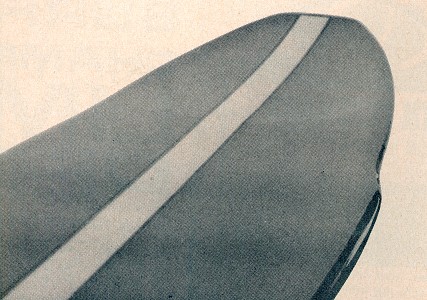 |
Jacobs Surfboards
422
Pacific Coast Hiway
Hermosa
Beach, Calif.
Phone
379-8366
|
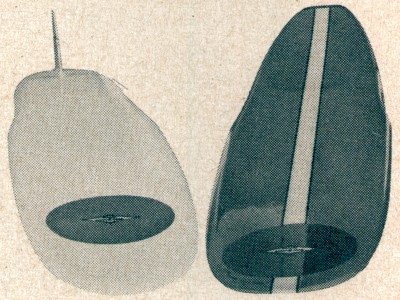 |
|
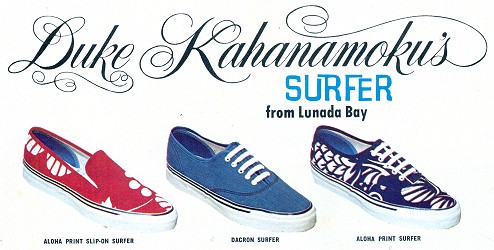 Lunada Bay Enterprises aloha print Surfer-Tennies
come in blue, red, green or yellow.
Lunada Bay Enterprises aloha print Surfer-Tennies
come in blue, red, green or yellow.
Get your Tennies and Wet
Suits now.
|
Page 90
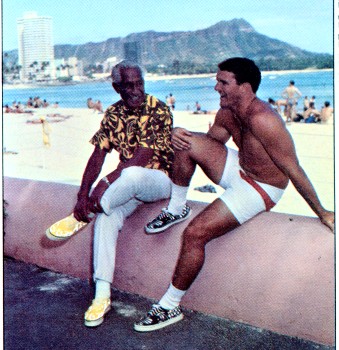
|
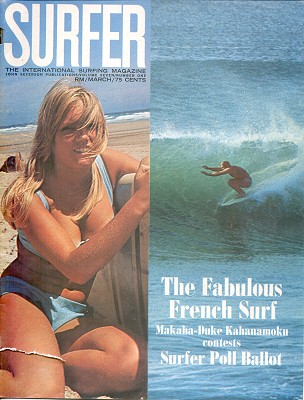
|
Surfer
Volume
7 Number 1,
March1966.
Cover:
John "Wheels" Williams, La Barre, France.
Photograph by Arnaud de Rosnay.
This
copy courtesy of the Graham Sorensen Collection.
|

surfresearch.com.au
Geoff Cater (2013) : Surfer
: Duke and Makaha Contests, 1965.
http://www.surfresearch.com.au/1966_Duke_Makaha_Contests_Surfer_v7n1_March.html








